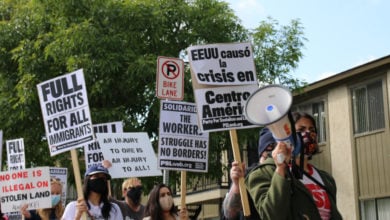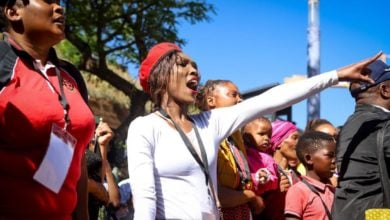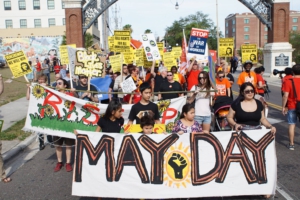 On May 1, workers and community members in Tampa gathered in the Ybor City Historic District to celebrate May Day and learn more about local working class history. They joined comrades around the country and the world who held large demonstrations in France, Kenya, South Korea, Indonesia, Turkey and elsewhere.
On May 1, workers and community members in Tampa gathered in the Ybor City Historic District to celebrate May Day and learn more about local working class history. They joined comrades around the country and the world who held large demonstrations in France, Kenya, South Korea, Indonesia, Turkey and elsewhere.
A multinational group of people filled the streets of Ybor with flags, signs and banners reading “Resist!”, “Black Lives Matter” and “Stop the war on workers.” Dozens of organizations representing organized labor, immigrant rights, Black liberation and other struggles marched and chanted throughout the city.
“May Day for me means it’s the one day of the year where we really get to celebrate what the Labor Movement has accomplished going back many, many years, what workers have accomplished in terms of fighting for their rights,” Marc Rodrigues with AFL-CIO told Liberation News.
May Day, or International Workers’ Day, originated in the late 19th century around the struggle for the eight-hour work day in Chicago. On May 1, 1886, thousands of workers went on strike and rallied across the country. When police shot and killed two workers in Chicago, organizers called a rally in the bustling commercial center known as Haymarket Square. At the Haymarket rally on May 4, a bomb was allegedly hurled at police who opened fire, killing and injuring many demonstrators.
As the struggle for the eight-hour work day grew, the American Federation of Labor called for another strike on May 1, 1890. AFL President Samuel Gompers wrote to the first congress of the Second International, an international association of socialist parties, which adopted a resolution calling for a worldwide demonstration to demand the eight-hour work day. It was a huge success.
Liberation asked Christian Brooks of Democratic Socialists of America about the meaning of May Day for socialists. “All the struggles and campaigns throughout the years that have centered around May Day have all been struggles for greater control over the conditions under which working class people work in capitalist society, and ultimately moving in the direction of real democratic control over all the conditions of production,” said Brooks.
On Monday, the march through Ybor City’s Historic District spread proletarian consciousness and historical knowledge by making educational stops at José Martí Park, the V.M. Ybor factory and The Castle.
Stop #1: José Martí Park
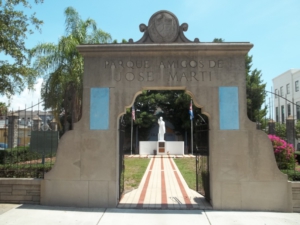 José Martí Park is the site of the home of Paulina Pedroso, an Afro-Cuban woman who was among the most prominent leaders in the fight for Cuba’s independence from Spain. She led grassroots organizing efforts in Ybor City to recruit Cuban exiles, and raise money for the cause of Cuban independence. When Cuban national hero and revolutionary philosopher José Martí visited Tampa, he stayed there with Pedroso. The home was often the site of meetings of revolutionaries, and became a hub of early community organizing in Ybor City in the 1890’s.
José Martí Park is the site of the home of Paulina Pedroso, an Afro-Cuban woman who was among the most prominent leaders in the fight for Cuba’s independence from Spain. She led grassroots organizing efforts in Ybor City to recruit Cuban exiles, and raise money for the cause of Cuban independence. When Cuban national hero and revolutionary philosopher José Martí visited Tampa, he stayed there with Pedroso. The home was often the site of meetings of revolutionaries, and became a hub of early community organizing in Ybor City in the 1890’s.
Stop #2: V.M. Ybor Factory
José Martí spoke on the iron steps of this cigar factory shortly before leaving to lead the Cuban War of Independence. But this factory is also the site of the beginnings of the Labor movement in Ybor City. In 1899, nearly 4,000 cigar workers walked off the job for 98 days. A movement known as La Resistencia grew out of this strike. Beginning with cigar workers, La Resistencia also organized dockworkers, restaurant workers, laundry workers, and other industries with the stated mission to “resist the exploitation of labor by capital”.
In May of 1901, La Resistencia led a march of over 1,000 workers to the Hillsborough county courthouse to demand the repair of a bridge over the Hillsborough river. They threatened a general strike and the city met their demands.
Stop #3: The Labor Temple Riot of 1932 (The Castle)
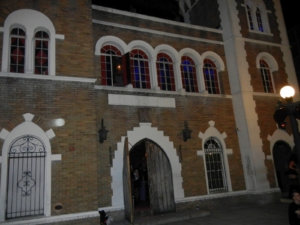 In the 1910’s and 20’s, Tampa’s cigar workers continued to organize, this time with the support of the AFL and the Cigar Makers International Union, and led major strikes in 1911 and in 1920. The Ybor Labor Temple, now a multilevel dance club known as The Castle, became offices and meeting spaces for the Ybor City unions in the 1930’s.
In the 1910’s and 20’s, Tampa’s cigar workers continued to organize, this time with the support of the AFL and the Cigar Makers International Union, and led major strikes in 1911 and in 1920. The Ybor Labor Temple, now a multilevel dance club known as The Castle, became offices and meeting spaces for the Ybor City unions in the 1930’s.
In 1931, at the height of the great depression, socialist workers planned to march through Tampa’s historically Black neighborhoods, carrying banners that read “Black and White, Unite and Fight,” challenging segregation and demanding economic change. As the march was beginning, police arrived armed with riot guns and fire hoses. A Labor Leader named Felix Marrero tried to show police a telegram from the Governor approving the march. Marrero was beaten and arrested. A riot broke out and 15 people were arrested. Workers held a general strike to protest the arrests, the last general strike to date in Ybor.
By bringing together workers and community members from many struggles and deepening their historical knowledge of class struggle, Monday’s march in Tampa instilled the local movements with greater class consciousness. Such education is crucial, as only a movement with a socialist, working class character can bring about significant, lasting social change.
As Vladimir Lenin wrote in 1904, “Let the celebration of May Day win thousands of new fighters to our cause and swell our forces in the great struggle for the freedom of all the people, for the liberation of all who toil under the yoke of capital!”



